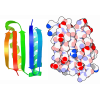[English] 日本語
 Yorodumi
Yorodumi- PDB-6r7q: Structure of XBP1u-paused ribosome nascent chain complex with Sec61. -
+ Open data
Open data
- Basic information
Basic information
| Entry | Database: PDB / ID: 6r7q | ||||||
|---|---|---|---|---|---|---|---|
| Title | Structure of XBP1u-paused ribosome nascent chain complex with Sec61. | ||||||
 Components Components |
| ||||||
 Keywords Keywords | RIBOSOME / translational pausing / XBP1 / UPR | ||||||
| Function / homology |  Function and homology information Function and homology informationepithelial cell maturation involved in salivary gland development / positive regulation of vascular wound healing / ATF6-mediated unfolded protein response / positive regulation of protein acetylation / Insertion of tail-anchored proteins into the endoplasmic reticulum membrane / membrane docking / response to insulin-like growth factor stimulus / glandular epithelial cell maturation / positive regulation of lactation / sterol homeostasis ...epithelial cell maturation involved in salivary gland development / positive regulation of vascular wound healing / ATF6-mediated unfolded protein response / positive regulation of protein acetylation / Insertion of tail-anchored proteins into the endoplasmic reticulum membrane / membrane docking / response to insulin-like growth factor stimulus / glandular epithelial cell maturation / positive regulation of lactation / sterol homeostasis / IRE1alpha activates chaperones / ATF6 (ATF6-alpha) activates chaperone genes / endoplasmic reticulum Sec complex / positive regulation of plasma cell differentiation / pronephric nephron development / positive regulation of phospholipid biosynthetic process / negative regulation of myotube differentiation / positive regulation of ERAD pathway / intracellular triglyceride homeostasis / cotranslational protein targeting to membrane / Ssh1 translocon complex / Sec61 translocon complex / protein targeting to ER / protein insertion into ER membrane / protein-transporting ATPase activity / cellular response to fructose stimulus / cellular response to laminar fluid shear stress / SRP-dependent cotranslational protein targeting to membrane, translocation / XBP1(S) activates chaperone genes / cellular response to nutrient / positive regulation of hepatocyte proliferation / signal sequence binding / cellular response to fluid shear stress / positive regulation of MHC class II biosynthetic process / negative regulation of endoplasmic reticulum unfolded protein response / post-translational protein targeting to membrane, translocation / exocrine pancreas development / positive regulation of vascular associated smooth muscle cell migration / ribosomal subunit / endothelial cell proliferation / cellular response to peptide hormone stimulus / positive regulation of B cell differentiation / positive regulation of immunoglobulin production / positive regulation of T cell differentiation / muscle organ development / IRE1-mediated unfolded protein response / negative regulation of SMAD protein signal transduction / ubiquitin ligase inhibitor activity / positive regulation of signal transduction by p53 class mediator / intrinsic apoptotic signaling pathway in response to endoplasmic reticulum stress / positive regulation of endothelial cell apoptotic process / cellular response to vascular endothelial growth factor stimulus / protein transmembrane transporter activity / positive regulation of TOR signaling / adipose tissue development / fatty acid homeostasis / 90S preribosome / vascular endothelial growth factor receptor signaling pathway / positive regulation of fat cell differentiation / neuron development / phagocytic cup / negative regulation of endoplasmic reticulum stress-induced intrinsic apoptotic signaling pathway / endoplasmic reticulum unfolded protein response / cellular response to glucose starvation / cis-regulatory region sequence-specific DNA binding / positive regulation of vascular associated smooth muscle cell proliferation / rough endoplasmic reticulum / ribosomal small subunit export from nucleus / translation regulator activity / gastrulation / ERAD pathway / MDM2/MDM4 family protein binding / positive regulation of autophagy / cytosolic ribosome / class I DNA-(apurinic or apyrimidinic site) endonuclease activity / DNA-(apurinic or apyrimidinic site) lyase / cellular response to interleukin-4 / response to endoplasmic reticulum stress / guanyl-nucleotide exchange factor activity / cholesterol homeostasis / cellular response to leukemia inhibitory factor / ribosomal large subunit biogenesis / maturation of LSU-rRNA from tricistronic rRNA transcript (SSU-rRNA, 5.8S rRNA, LSU-rRNA) / nuclear estrogen receptor binding / positive regulation of apoptotic signaling pathway / maturation of SSU-rRNA from tricistronic rRNA transcript (SSU-rRNA, 5.8S rRNA, LSU-rRNA) / RNA polymerase II transcription regulatory region sequence-specific DNA binding / maturation of SSU-rRNA / cellular response to amino acid stimulus / cellular response to glucose stimulus / small-subunit processome / regulation of cell growth / phosphatidylinositol 3-kinase/protein kinase B signal transduction / liver development / negative regulation of transforming growth factor beta receptor signaling pathway / protein destabilization / phospholipid binding / regulation of protein stability / chromatin DNA binding / negative regulation of ERK1 and ERK2 cascade Similarity search - Function | ||||||
| Biological species |  Homo sapiens (human) Homo sapiens (human)   | ||||||
| Method | ELECTRON MICROSCOPY / single particle reconstruction / cryo EM / Resolution: 3.9 Å | ||||||
 Authors Authors | Shanmuganathan, V. / Cheng, J. / Braunger, K. / Berninghausen, O. / Beatrix, B. / Beckmann, R. | ||||||
| Funding support |  Germany, 1items Germany, 1items
| ||||||
 Citation Citation |  Journal: Elife / Year: 2019 Journal: Elife / Year: 2019Title: Structural and mutational analysis of the ribosome-arresting human XBP1u. Authors: Vivekanandan Shanmuganathan / Nina Schiller / Anastasia Magoulopoulou / Jingdong Cheng / Katharina Braunger / Florian Cymer / Otto Berninghausen / Birgitta Beatrix / Kenji Kohno / Gunnar von ...Authors: Vivekanandan Shanmuganathan / Nina Schiller / Anastasia Magoulopoulou / Jingdong Cheng / Katharina Braunger / Florian Cymer / Otto Berninghausen / Birgitta Beatrix / Kenji Kohno / Gunnar von Heijne / Roland Beckmann /    Abstract: XBP1u, a central component of the unfolded protein response (UPR), is a mammalian protein containing a functionally critical translational arrest peptide (AP). Here, we present a 3 Å cryo-EM ...XBP1u, a central component of the unfolded protein response (UPR), is a mammalian protein containing a functionally critical translational arrest peptide (AP). Here, we present a 3 Å cryo-EM structure of the stalled human XBP1u AP. It forms a unique turn in the ribosomal exit tunnel proximal to the peptidyl transferase center where it causes a subtle distortion, thereby explaining the temporary translational arrest induced by XBP1u. During ribosomal pausing the hydrophobic region 2 (HR2) of XBP1u is recognized by SRP, but fails to efficiently gate the Sec61 translocon. An exhaustive mutagenesis scan of the XBP1u AP revealed that only 8 out of 20 mutagenized positions are optimal; in the remaining 12 positions, we identify 55 different mutations increase the level of translational arrest. Thus, the wildtype XBP1u AP induces only an intermediate level of translational arrest, allowing efficient targeting by SRP without activating the Sec61 channel. | ||||||
| History |
|
- Structure visualization
Structure visualization
| Movie |
 Movie viewer Movie viewer |
|---|---|
| Structure viewer | Molecule:  Molmil Molmil Jmol/JSmol Jmol/JSmol |
- Downloads & links
Downloads & links
- Download
Download
| PDBx/mmCIF format |  6r7q.cif.gz 6r7q.cif.gz | 4.8 MB | Display |  PDBx/mmCIF format PDBx/mmCIF format |
|---|---|---|---|---|
| PDB format |  pdb6r7q.ent.gz pdb6r7q.ent.gz | Display |  PDB format PDB format | |
| PDBx/mmJSON format |  6r7q.json.gz 6r7q.json.gz | Tree view |  PDBx/mmJSON format PDBx/mmJSON format | |
| Others |  Other downloads Other downloads |
-Validation report
| Summary document |  6r7q_validation.pdf.gz 6r7q_validation.pdf.gz | 1.6 MB | Display |  wwPDB validaton report wwPDB validaton report |
|---|---|---|---|---|
| Full document |  6r7q_full_validation.pdf.gz 6r7q_full_validation.pdf.gz | 1.9 MB | Display | |
| Data in XML |  6r7q_validation.xml.gz 6r7q_validation.xml.gz | 378.4 KB | Display | |
| Data in CIF |  6r7q_validation.cif.gz 6r7q_validation.cif.gz | 644.9 KB | Display | |
| Arichive directory |  https://data.pdbj.org/pub/pdb/validation_reports/r7/6r7q https://data.pdbj.org/pub/pdb/validation_reports/r7/6r7q ftp://data.pdbj.org/pub/pdb/validation_reports/r7/6r7q ftp://data.pdbj.org/pub/pdb/validation_reports/r7/6r7q | HTTPS FTP |
-Related structure data
| Related structure data |  4745MC  4729C  4735C  4737C  6r5qC  6r6gC  6r6pC M: map data used to model this data C: citing same article ( |
|---|---|
| Similar structure data |
- Links
Links
- Assembly
Assembly
| Deposited unit | 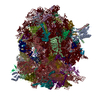
|
|---|---|
| 1 |
|
- Components
Components
-40S ribosomal protein ... , 8 types, 8 molecules AABBCCJJRRuxz
| #1: Protein | Mass: 6317.539 Da / Num. of mol.: 1 / Source method: isolated from a natural source / Source: (natural)  |
|---|---|
| #2: Protein | Mass: 21629.309 Da / Num. of mol.: 1 / Source method: isolated from a natural source / Source: (natural)  |
| #3: Protein | Mass: 24003.012 Da / Num. of mol.: 1 / Source method: isolated from a natural source / Source: (natural)  |
| #10: Protein | Mass: 9348.990 Da / Num. of mol.: 1 / Source method: isolated from a natural source / Source: (natural)  |
| #28: Protein | Mass: 13048.244 Da / Num. of mol.: 1 / Source method: isolated from a natural source / Source: (natural)  |
| #76: Protein | Mass: 24759.145 Da / Num. of mol.: 1 / Source method: isolated from a natural source / Source: (natural)  |
| #79: Protein | Mass: 29523.674 Da / Num. of mol.: 1 / Source method: isolated from a natural source / Source: (natural)  |
| #81: Protein | Mass: 27471.535 Da / Num. of mol.: 1 / Source method: isolated from a natural source / Source: (natural)  |
-Ribosomal protein ... , 19 types, 19 molecules DDEEFF6OOQQIJMNWYjpwyTTUUVV
| #4: Protein | Mass: 21649.633 Da / Num. of mol.: 1 / Source method: isolated from a natural source / Source: (natural)  |
|---|---|
| #5: Protein | Mass: 17586.766 Da / Num. of mol.: 1 / Source method: isolated from a natural source / Source: (natural)  |
| #6: Protein | Mass: 7007.069 Da / Num. of mol.: 1 / Source method: isolated from a natural source / Source: (natural)  |
| #20: Protein | Mass: 34669.113 Da / Num. of mol.: 1 / Source method: isolated from a natural source / Source: (natural)  |
| #25: Protein | Mass: 8526.119 Da / Num. of mol.: 1 / Source method: isolated from a natural source / Source: (natural)  |
| #27: Protein | Mass: 17057.113 Da / Num. of mol.: 1 / Source method: isolated from a natural source / Source: (natural)  |
| #37: Protein | Mass: 24511.861 Da / Num. of mol.: 1 / Source method: isolated from a natural source / Source: (natural)  |
| #38: Protein | Mass: 19399.498 Da / Num. of mol.: 1 / Source method: isolated from a natural source / Source: (natural)  |
| #41: Protein | Mass: 16217.355 Da / Num. of mol.: 1 / Source method: isolated from a natural source / Source: (natural)  |
| #42: Protein | Mass: 24076.088 Da / Num. of mol.: 1 / Source method: isolated from a natural source / Source: (natural)  |
| #51: Protein | Mass: 14131.536 Da / Num. of mol.: 1 / Source method: isolated from a natural source / Source: (natural)  |
| #53: Protein | Mass: 15891.787 Da / Num. of mol.: 1 / Source method: isolated from a natural source / Source: (natural)  |
| #65: Protein | Mass: 10090.891 Da / Num. of mol.: 1 / Source method: isolated from a natural source / Source: (natural)  |
| #71: Protein | Mass: 10168.153 Da / Num. of mol.: 1 / Source method: isolated from a natural source / Source: (natural)  |
| #78: Protein | Mass: 25215.586 Da / Num. of mol.: 1 / Source method: isolated from a natural source / Source: (natural)  |
| #80: Protein | Mass: 21525.941 Da / Num. of mol.: 1 / Source method: isolated from a natural source / Source: (natural)  |
| #82: Protein | Mass: 14734.357 Da / Num. of mol.: 1 / Source method: isolated from a natural source / Source: (natural)  |
| #83: Protein | Mass: 16032.804 Da / Num. of mol.: 1 / Source method: isolated from a natural source / Source: (natural)  |
| #84: Protein | Mass: 15626.392 Da / Num. of mol.: 1 / Source method: isolated from a natural source / Source: (natural)  |
+Protein , 43 types, 43 molecules GGHHIIKKLLMM09NNPPABCFGHOPQRSTUVXSSabcd...
-Protein/peptide , 2 types, 2 molecules 1l
| #15: Protein/peptide | Mass: 2895.380 Da / Num. of mol.: 1 Source method: isolated from a genetically manipulated source Source: (gene. exp.)  Homo sapiens (human) / Gene: XBP1, TREB5, XBP2 / Production host: Homo sapiens (human) / Gene: XBP1, TREB5, XBP2 / Production host:  |
|---|---|
| #67: Protein/peptide | Mass: 6324.579 Da / Num. of mol.: 1 / Source method: isolated from a natural source / Source: (natural)  |
-RNA chain , 7 types, 7 molecules 234578K
| #16: RNA chain | Mass: 24108.330 Da / Num. of mol.: 1 / Source method: isolated from a natural source / Source: (natural)  |
|---|---|
| #17: RNA chain | Mass: 24148.355 Da / Num. of mol.: 1 / Source method: isolated from a natural source / Source: (natural)  |
| #18: RNA chain | Mass: 1877.157 Da / Num. of mol.: 1 / Source method: obtained synthetically / Source: (synth.)  Homo sapiens (human) Homo sapiens (human) |
| #19: RNA chain | Mass: 1148460.625 Da / Num. of mol.: 1 / Source method: isolated from a natural source / Source: (natural)  |
| #21: RNA chain | Mass: 38691.914 Da / Num. of mol.: 1 / Source method: isolated from a natural source / Source: (natural)  |
| #22: RNA chain | Mass: 48545.672 Da / Num. of mol.: 1 / Source method: isolated from a natural source / Source: (natural)  |
| #39: RNA chain | Mass: 548040.188 Da / Num. of mol.: 1 / Source method: isolated from a natural source / Source: (natural)  |
-60S ribosomal protein ... , 6 types, 6 molecules DELZin
| #32: Protein | Mass: 34077.391 Da / Num. of mol.: 1 / Source method: isolated from a natural source / Source: (natural)  |
|---|---|
| #33: Protein | Mass: 28818.293 Da / Num. of mol.: 1 / Source method: isolated from a natural source / Source: (natural)  |
| #40: Protein | Mass: 24200.525 Da / Num. of mol.: 1 / Source method: isolated from a natural source / Source: (natural)  |
| #54: Protein | Mass: 15704.635 Da / Num. of mol.: 1 / Source method: isolated from a natural source / Source: (natural)  |
| #64: Protein | Mass: 11888.371 Da / Num. of mol.: 1 / Source method: isolated from a natural source / Source: (natural)  |
| #69: Protein/peptide | Mass: 3473.451 Da / Num. of mol.: 1 / Source method: isolated from a natural source / Source: (natural)  |
-Protein transport protein Sec61 subunit ... , 3 types, 3 molecules XXYYZZ
| #86: Protein | Mass: 50728.480 Da / Num. of mol.: 1 / Source method: isolated from a natural source / Source: (natural)  |
|---|---|
| #87: Protein | Mass: 7019.456 Da / Num. of mol.: 1 / Source method: isolated from a natural source / Source: (natural)  |
| #88: Protein/peptide | Mass: 3265.008 Da / Num. of mol.: 1 / Source method: isolated from a natural source / Source: (natural)  |
-Non-polymers , 2 types, 305 molecules 


| #89: Chemical | ChemComp-ZN / #90: Chemical | ChemComp-MG / |
|---|
-Experimental details
-Experiment
| Experiment | Method: ELECTRON MICROSCOPY |
|---|---|
| EM experiment | Aggregation state: PARTICLE / 3D reconstruction method: single particle reconstruction |
- Sample preparation
Sample preparation
| Component |
| ||||||||||||||||||||||||||||||||||||||||||
|---|---|---|---|---|---|---|---|---|---|---|---|---|---|---|---|---|---|---|---|---|---|---|---|---|---|---|---|---|---|---|---|---|---|---|---|---|---|---|---|---|---|---|---|
| Source (natural) |
| ||||||||||||||||||||||||||||||||||||||||||
| Source (recombinant) |
| ||||||||||||||||||||||||||||||||||||||||||
| Buffer solution | pH: 7.5 | ||||||||||||||||||||||||||||||||||||||||||
| Specimen | Embedding applied: NO / Shadowing applied: NO / Staining applied: NO / Vitrification applied: YES | ||||||||||||||||||||||||||||||||||||||||||
| Vitrification | Cryogen name: ETHANE |
- Electron microscopy imaging
Electron microscopy imaging
| Experimental equipment |  Model: Titan Krios / Image courtesy: FEI Company |
|---|---|
| Microscopy | Model: FEI TITAN KRIOS |
| Electron gun | Electron source:  FIELD EMISSION GUN / Accelerating voltage: 300 kV / Illumination mode: SPOT SCAN FIELD EMISSION GUN / Accelerating voltage: 300 kV / Illumination mode: SPOT SCAN |
| Electron lens | Mode: BRIGHT FIELD |
| Image recording | Electron dose: 28 e/Å2 / Film or detector model: FEI FALCON II (4k x 4k) |
- Processing
Processing
| CTF correction | Type: NONE |
|---|---|
| Symmetry | Point symmetry: C1 (asymmetric) |
| 3D reconstruction | Resolution: 3.9 Å / Resolution method: FSC 0.143 CUT-OFF / Num. of particles: 12749 / Symmetry type: POINT |
| Atomic model building | Protocol: RIGID BODY FIT |
 Movie
Movie Controller
Controller


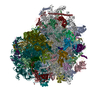
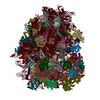
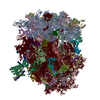
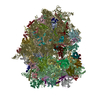


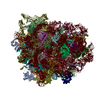
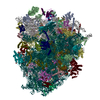

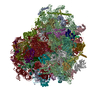
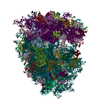
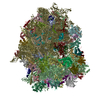
 PDBj
PDBj





























